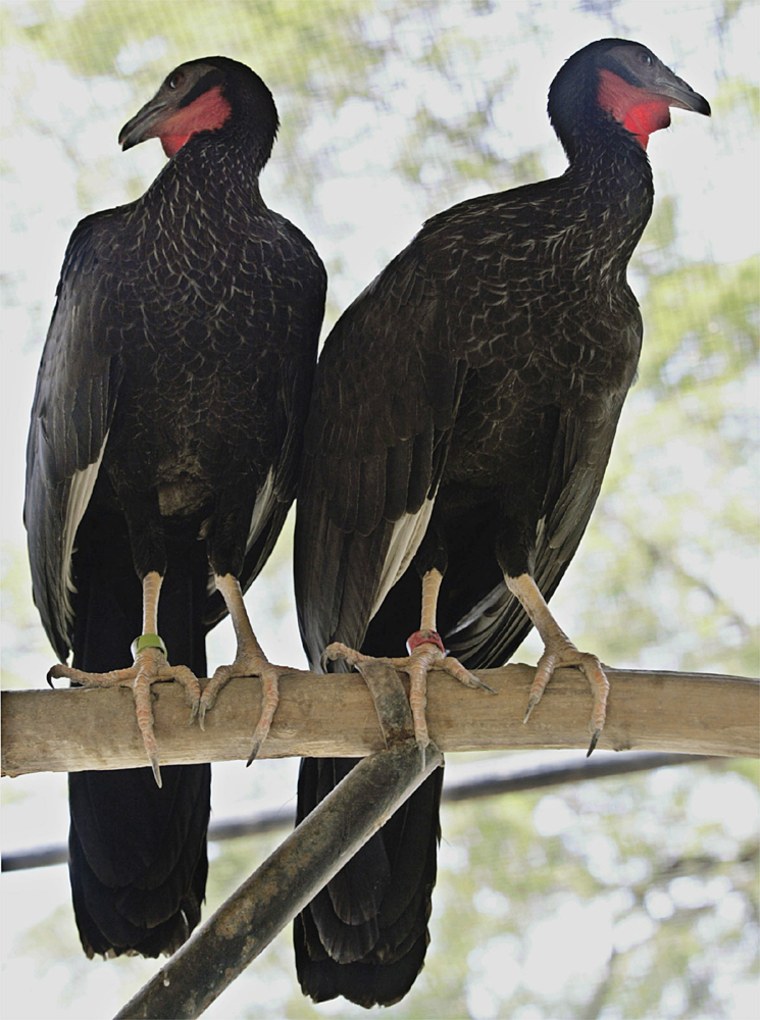A quarter of a century ago, Peru’s white-winged guan — a species native only to this Andean bird paradise — was considered as dead as a dodo.
Discovered in 1877 by a Polish ornithologist, it was believed extinct for 100 years until its rediscovery in 1977 by Gustavo del Solar, a hunter-turned-conservationist who founded a special breeding project to reintroduce it to the wild.
But now, the white-winged guan — a species that came back to life like a phoenix but remains endangered, with only an estimated 300 in the wild — faces extinction again unless del Solar can raise fresh cash to keep his project in northern Peru going.
“I’ll make a final, heartfelt effort, but if I can’t raise international or national aid in 2004, I’ll send a letter to the conservation authorities saying they have six months to see how to finance the project, because I can’t continue,” he told Reuters in his Lima apartment, the walls studded with antelope and buffalo trophies shot on hunting trips in Africa.
Farmer, hunter, and now conservationist
A farmer with tamarind plantations in northern Peru, del Solar long ago gave up his hunting hobby and has devoted the past quarter-century to conserving the bird he helped revive.
On part of his land, about 500 miles (800 kilometers) north of Lima in Peru’s hot coastal desert strip, the breeding sanctuary is now home to 90 white-winged guan.
There, in peaceful surroundings, the long-tailed black birds, with their distinctive white feathered wings and red throats, live in individual pens in six circular aviaries.
Often nervous — they can die of stress and are kept separate because they can fight — the guan have successfully reproduced in captivity since the center was opened in 1978.
But the aim was always to reintroduce the guan back into the wild to ensure the survival of the species.
Peru has the second-highest number of bird species in the world behind Colombia, and the guan, also known by its scientific name Penelope albipennis, has been officially classified as endangered since 1990.
Only half the battle
In 2000, 16 adult guan — wearing radio transmitter ”backpacks” to allow their progress to be checked — were released, the center’s manager, Fernando Angulo, told Reuters.
The moment they had all been waiting for came the following year, when the first chick was born in the wild to reintroduced parents. To date, three guan chicks have been born in the wild and another six birds have been released, but Angulo said around half of the reintroduced guan have died.
But setting the birds free is only half the battle.
“What we’re thinking of is how to ensure that an animal at risk doesn’t become extinct. Because if you go to the places where the guan lives, people don’t understand conservation,” Angulo said. “You have to make conservation pay.”
The guan live in the so-called dry forest, an ecosystem in northern Peru in which the trees are dry and leafless except during summer rains. There they are at risk from locals who hunt them for food and who raid the forest for timber.
Angulo said he was seeking to involve local communities in the conservation effort — perhaps by acting as guides or providing services to rich American and European tourists. A visitors’ fee could also be levied to ensure that cash from vacationing bird watchers made its way to residents.
Protecting the forests for the guan in that way would also have an “umbrella effect” and safeguard other species, he said, adding that about 40 bird species are native to the dry forest.
“It’s the only way to prevent the (white-winged guan) from dying out,” Angulo said.
Looking for money
Del Solar’s center is currently funded by a charitable foundation owned by the Backus & Johnston brewing company, a unit of Colombia’s Bavaria, at a cost of about $55,000 a year. But Del Solar said he did not expect the brewer to fund the project forever because it supports a range of other activities.
He said it really needed another $50,000 to be able to reintroduce the birds into the wild en masse — a vital next step to consolidate the conservation efforts.
While he acknowledged that the white-winged guan was no beautiful bird of paradise, he said its loss — particularly after what he called its “phoenixlike” resurrection and such strenuous efforts to re-establish it — would be a severe blow for conservationists.
Del Solar has championed efforts to have the white-winged guan named Peru’s national bird, but efforts have so far come to nothing.
With plaques and public congratulations, Peru has thanked Del Solar for his efforts to save the guan.
“That can satisfy my ego. But I’d 100 times rather change all that for financial assistance,” he said.
